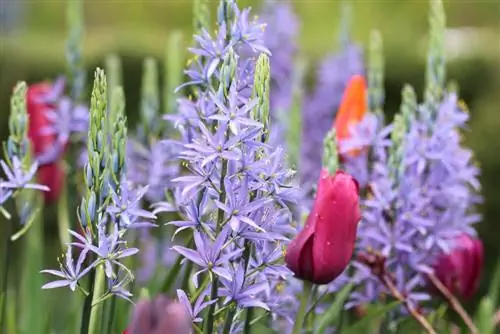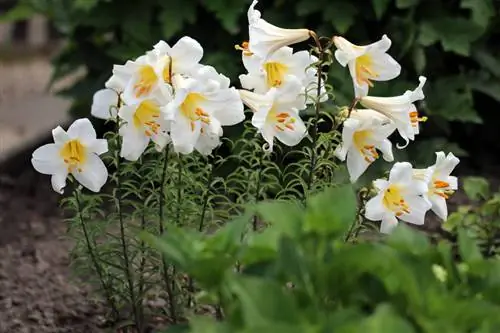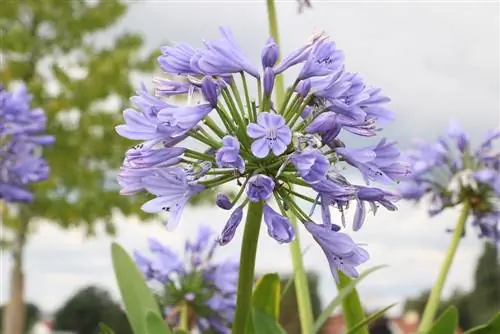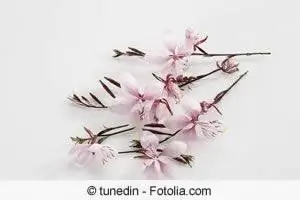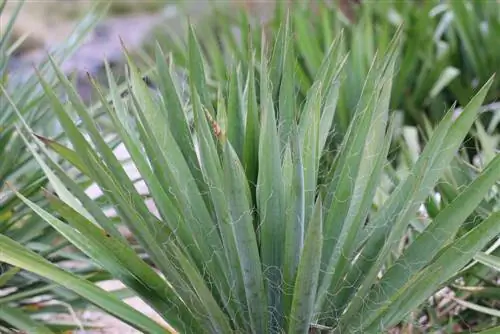- Author admin [email protected].
- Public 2023-12-17 03:39.
- Last modified 2025-01-24 12:45.
When the flowering of tulips and other early bloomers comes to an end in spring, there is often a pause until the next plant develops its new splendor. The Camassia, also known colloquially as the prairie lily, can close this gap. And she does it brilliantly with small star-shaped flowers that can grow up to 100 times.
Profile
- Care effort: Low. Easy care
- Flowering time: early to mid-summer with star-shaped flowers in white, blue or purple on upright stems
- Foliage: lanceolate, narrow, overhanging in green, sometimes also edged in yellow
- Growth: Dense rosette of leaves from which the flower stalks protrude
- Height/width: Depending on the variety, 35 to 70cm high and 30 to 40cm wide
- Location: Sunny or partially shaded. Nutrient-rich and moist soil, also tolerates heavy soil
- Planting time: autumn. Onion circumference 6-8cm
- Pruning: No pruning necessary. Only remove yellowed parts
- Partner: Solitaire
- Care: Water when dry, soil should not dry out. Fertilize in spring and early summer, alternatively give long-term fertilizer in spring
- Wintering: Somewhat sensitive to frost, therefore requires winter protection
- Illnesses/problems: problem-free
- Special features: Does not belong to the lilies as the German name suggests, but is botanically one of the perennials because it is perennial, even if it is a bulb flower
- `Blue Melody: height 40-50cm. Blooms from May with bright foliage. In addition to the flowers, it also has green, yellow-edged leaves. Onion circumference 6-8cm
Origin
This onion plant is originally native to North America and South America and owes its name to the Indians. The women of the Nez Perce, Cree and Blackfoot tribes in particular collected and cooked the onions.
Description
Despite its additional name, prairie lily, the Camassia does not belong to the lilies, as might be assumed, but to the hyacinth family and includes around 15 varieties. The flowers usually have a delicate blue-violet color. Some other species appear cream-colored or bright blue.
The flowers are always raceme-shaped, about 5 cm tall and open from bottom to top. The leaves of this plant are long, arching, thin and arranged like a rosette around the tall flower stalk. Under ideal conditions, which means a humus-like soil as a decisive factor, the camassia can rise up to one meter. The flowering period extends from April to June.
Particularly commonly used species of Camassia are:
- Camassia cusickii with lavender flowers,
- Camassia esculenta with a deep blue splendor,
- Camassia Leichtlinii presents itself in shades of blue and cream. This is highly recommended as it has proven to be very durable and
- Camassia quamash also with blue flowers
Planting
The onions should be bought as early in the year as possible, in any case before they have started sprouting. Care must be taken to ensure that these are firm and he althy specimens. There must be no soft spots and the onion must be free of any signs of damage. With particularly small bulbs, there is a risk that they will not produce any flowers in the first year. The onions must be put into the ground as quickly as possible after purchase.
The best location is sunny to light partial shade. The soil should be permeable and nutrient-rich. Some compost or organic fertilizer can be added in spring as fertilizer. It is also important that the planting site has a high level of humidity without the risk of waterlogging. If it's still wet, the onions can start to rot. Prolonged dryness should also be avoided.
This plant also thrives excellently in groups in meadows. When planted in large quantities together with daffodils, Camassia creates an impressive picture.
The bulbs are placed approx. 10-15 cm deep in the soil at their location. The depth depends on the size of the onion, a guideline is approximately 2-3 times the thickness of the onion. The more circumference, the further the onion is placed into the ground.
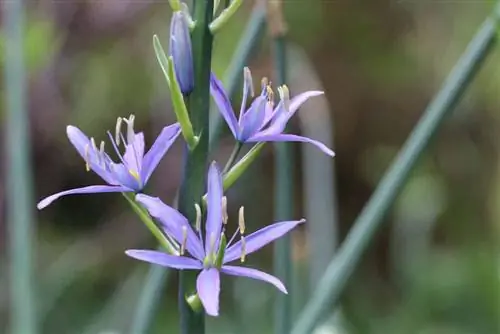
When planting in a container, a clay container is the better choice for onion plants. The water can dry better after watering than in plastic containers. The drainage hole in the clay pot is first closed with a piece of clay. A piece of zinc can be inserted to prevent worms from entering. The potting soil is then filled with the onion, the soil is pressed down, watered vigorously and placed in a sunny spot. It should be noted that the planting is just as deep as outdoors.
Care
The plant is very easy to care for and rarely affected by diseases. Prairie lilies, on the other hand, are susceptible to root nematodes. Also known as nematodes or nematodes, they can only be seen with a magnifying glass. This problem can be recognized by the leaves, which wither and become stunted. Spots and thickenings also appear there and the prairie lily shows slow growth. The only measure that can be taken is to destroy the plant in question. To combat it, you can plant marigolds and marigolds. The marigold in particular secretes fragrances through its roots. Attracted to this, the nematodes penetrate the roots of the marigolds and are immediately eliminated by a toxin.
After successful flowering, only the withered part should be removed. The leaves are only cut off in June, but then only when they have dried out. The time can also be postponed until later as it depends on the location. The sunnier the Camassia is, the faster the leaves wither.
Binding leaves that are still green together for the sake of order should be avoided, as photosynthesis is disrupted and the bulb can then store less energy for the next growing season.
Propagation
The prairie lily reproduces via daughter bulbs that can be divided during the dormant phase in summer or autumn. The plant also self-sows extensively and is therefore suitable for naturalization. The flowering ability becomes apparent after 3-4 years.
Wintering
The Camassia is only partially hardy. If it is planted in the outdoor garden, it should be additionally protected with an organic cover during longer cold periods below -6 degrees Celsius. When planting in containers, staying outdoors during the winter is not possible. A frost-proof place is then preferable.
Even if a really cold winter is generally expected, it is recommended to dig up the bulbs and store them in a dark, dry and frost-free area until next spring.
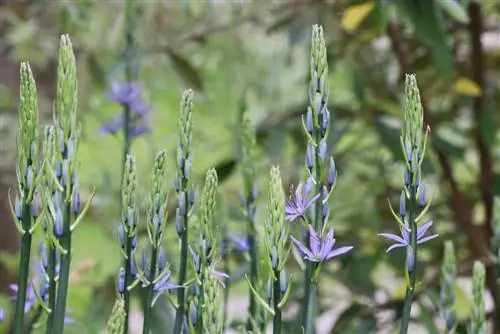
Many bulbous plants are of course also suitable as cut flowers for spring at home, including Camassia. Another option is to start growing indoors in the winter. This works by first storing the onions in a dry place in the dark for several months and then exposing them to light. This causes flowering to occur early and the owner can enjoy the new flowers sooner.

